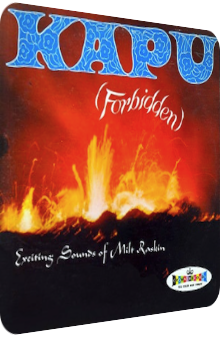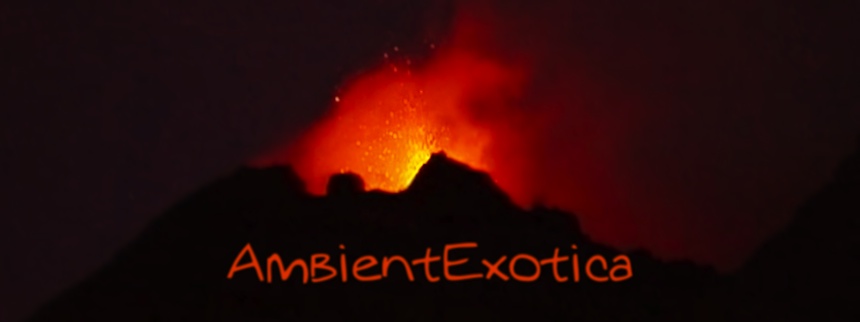
Milt Raskin
Kapu
1959
Exotica fans often lament about the rareness of records that are thus hard to collect and expensive to buy. Reversely, the happiness about an ultra-rare, tremendously sought after record in one‘s collection should not distract from the circumstance that this record is also lost to everyone else – "as it should be," a sarcastic soul might add. However, the collectibility of rare vinyl doesn‘t necessarily decrease if a record label decides to re-release an album in digital form solely, ready to be downloaded on digital music stores. In fact, I prefer this admittedly patronizing solution due to the contentment of everyone involved: true collectors continue being happy about their physical vinyl treasure, music lovers of the Exotica genre have the opportunity to listen to a long-lost record in (hopefully) good quality for a reasonable price, and lastly, record labels can revise the popularity of certain records and reconsider their digital strategies, if necessary, by remastering other gemstones from their archives.
With Milt Raskin‘s Kapu however, originally released in 1959 by Crown Records, the re-release tactics got out of hands. First of all, one should be thankful for a digital re-release, as am I for sure, but at the time of writing, Kapu can be found 8 times on the iTunes Store with several different artworks … and several different album and track titles! The problem of this confusion already arose in the year of its original release, since it was first known for its name Exotic Percussion and shortly thereafter was released with a more appealing artwork on front, this time with the name Kapu (Forbidden), but otherwise featuring the same tracks nonetheless. Hence, the original Kapu (Forbidden) is also known as Exotic Percussion, Exotic Tiki Sounds of Hawaii and Tiki Sounds From The Islands – to make matters worse, the audio quality varies between the releases and the track titles differ as well: for example, the much beloved Koko Head tune, as it is originally called, becomes Pele‘s Creation or, possibly due to a typographic error, Pete‘s Creation on yet another release of the same album. Yes, a lot of music lovers are happy about this re-release, but which one should they turn their attention to? After all, if one chooses the wrong version, all one hears is terribly muffled and fuzzy sound, especially percussion-wise.
This is just a mess, I‘m sorry to say, as this masterpiece deserves every attention it can get, but as it is often the case, less is more. Personally, I would choose the version produced by Flair Records in 2006, as it features all 10 tracks in the right order with their right names, in Stereo. Unfortunately, the original artwork of the 2nd LP release – the one with the erupting volcano as seen above – is replaced with a boring close-up picture of the actual vinyl itself, about which I won‘t complain because in the end, it‘s the music that matters the most, especially since we‘re talking about the digital version here and aside from that, you can easily swap the digital artwork and replace it with a digital rendition of the original artwork.
Kapu is the title of the first song and starts with a Bossa Nova groove, a great piano, two accordions, xylophones and exotic percussion. The pace of the track changes after two minutes, speeding things up and putting the piano together with the flute into the spotlight. At the end, things get even more exotic with the addition of man-made bird noises. The following Koko Head is one of my favorite tracks, consisting of sophisticated percussion with the help of bongos, a remarkably memorable main melody played first by a flute and then by a piano. The result is a refreshing blending of exotic elements with Western Jazz.
Maika, however, is the signature track of the album and one of the most beautiful Exotica songs ever produced. A very mellow track with a pair of flutes and gentle vibraphones in the background. The care-free melody played by the flutes is gorgeous, but things get even better when a harp is introduced for a short time in the middle of the track which is played alongside the piano. On one of my famous side notes, the Exotica quartet (oftentimes reshaping to a 22-people Big Band) Mr. Ho's Orchestrotica plays an utterly beautiful version of Maika on their second album Third River Rangoon. Anyway, back to Milt Raskin's Kapu: Moon Festival is a swift percussion-driven tune, its signature elements being a rock organ and a quickly played accordion, while on Mileka the piano is played in the most salient way on the whole LP, almost literally jumping out of the speakers or headphones. Here, the accordion is played rather sustainedly and a low-keyed rock organ is on board yet again.
On Lanikai, the longest track, exotic bird noises can be heard once more while the mood of the song hints to something exciting and potentially dangerous as the beats are dominant here and the polyphonic main melody is strangely enigmatic, until after around 90 seconds when the stomping beats lose their danger as the inescapable accordion is first heard in this track. The flute is playful, the rock organ soothing and yet, this song is similarly ritualistic as Moon Festival. The last track, Telani, ends things with a laid back bongo groove and the use of all instruments previously featured on Kapu. Curiously, the song has a cliché Venetian feel to it that doesn‘t vanish until the end, even though the dynamically played piano that is typical for Raskin‘s production takes over in the end.
The mood evoked by this release is that of a Polynesian island due to the great use of flutes and bongos. Since most instruments are played polyphonically, each song sounds ritualistic and celebratory. By adding accordions and pianos, Raskin follows the same formula used in other releases of the 50‘s in introducing the foreign with the help of the common. In the end, Kapu fails in giving a realistic glimpse into the realm of Polynesian or exotic music in general, but the entanglement of its ingredients works great and the constant use of a piano on every song doesn‘t grow tiresome due to the dynamic way it is played. It works especially well when the piano, played by Raskin himself, takes over the song for a short time, bursting vibrant staccato chords into the arrangment.
As the blending of all these ingredients is unusual enough, the contemporary listener could potentially think of this as a verisimilar record that captures the Polynesian spirit and enhances it with Western instruments. As it is often the case with Exotica releases, this is anything of the above but an accomplished imitation of the truth – plastic dreams, if you like. The album is nonetheless recommended for lovers of cinematic music heard in insular settings. Raskin‘s Hollywood approach of the exotic topos plus the fact that all songs are his own concoctions that usually work quite well or are exceptionally alluring like Maika or playful like Koko Head will keep you entertained at worst, or inspire you to come back to certain songs of this release time and again at best.
Further reading:
Yep, there's also a SpaceAgePop.com synopsis for Milt Raskin. The most surprising fact is that Raskin considered Kapu as one of his weaker works. Well, in this case I'm glad of my missing taste!
Exotica Review 007: Milt Raskin – Kapu (1959). Originally published on Dec. 18, 2011 at AmbientExotica.com.
